Popular Posts
Tuesday 26 March 2024
Philosophy: My Posts (or Tweets) on X (6)
Sunday 24 March 2024
Margaret Boden on Artificial Intelligence (AI) and Consciousness
The following essay is a commentary on — and reaction to — Margaret Boden’s book AI: Its Nature and Future. In this book Boden discusses various technological, scientific and philosophical issues raised by artificial intelligence. Specifically, she tackles the issue of whether programs could ever be “genuinely intelligent, creative or even conscious”.
This essay isn’t a book review.

Part One:
Part Two:
As for my essay, I’ll be focussing specifically on what Boden has to say on consciousness. However, I’ll be placing this subject within the context of artificial intelligence (AI), which forms the basis of Boden’s own book.
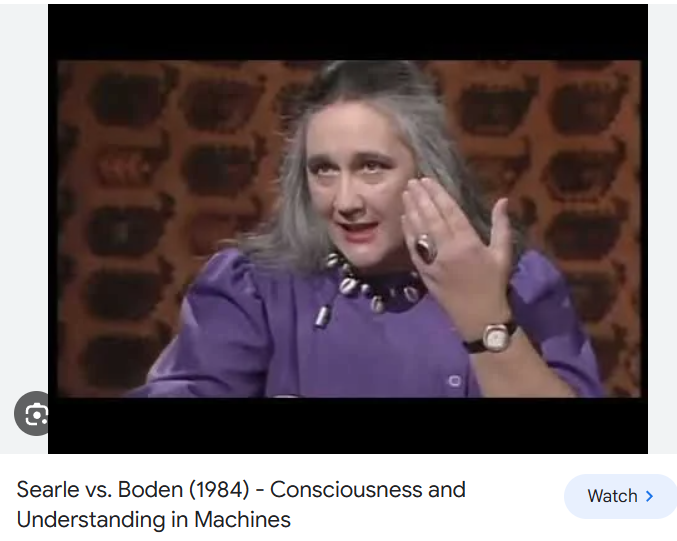
Margaret A. Boden was born in 1936. She’s a Research Professor of Cognitive Science who’s worked in the fields of artificial intelligence, psychology, cognitive science, computer science, and philosophy.
She was awarded a PhD in social psychology (her specialism was cognitive studies) by Harvard in 1968. Boden became a Fellow of the British Academy in 1983, and served as its vice-president from 1989 to 1991. In 2001, Boden was appointed an OBE for her services in the field of cognitive science.
Part One
Margaret Boden on Consciousness… and Zombies

Given that Margaret Boden moves on to discuss consciousness in her book AI: Its Nature and Future (i.e., pages 120 to 146), it was almost inevitable that she’d also discuss zombies. (In the literature, philosophical zombies.)
Boden tells us that for the American philosopher Daniel Dennett and the philosopher and researcher (i.e., on artificial intelligence) Aaron Sloman (whom Boden mentions a fair few times in her book), “the concept of zombie is incoherent”.
[See note 1 on the words “incoherent” and “meaningless”.]
Why is that?
Boden continued:
“Given the appropriate behaviour and/or virtual machine, consciousness — for Sloman, even including qualia — is guaranteed. The Turing Test is therefore saved from the objection that it might be ‘passed’ by a zombie.”
Many would deem this to be an account of a very-crude type of behaviourism. That’s even if, in this instance, it’s being applied to a zombie, and also includes a reference to a “virtual machine”.
In detail.
To argue that
“[g]iven the appropriate behaviour and/or virtual machine, consciousness [] is guaranteed”
is surely a behaviourist position. [See note 2.]
Is such “appropriate behaviour” or the relevant “virtual machine” what consciousness is?
Alternatively, does such appropriate behaviour or the relevant virtual machine bring about consciousness?
It will be seen later that the virtual machines must be implemented in physical media — despite their (as it were) virtuality. As for behaviour (including verbal behaviour) being what consciousness is, that seems almost impossible to accept.
Is it, then, that a virtual machine can manifest (or instantiate) consciousness — regardless of behaviour and physical implementation? In other words, is consciousness simply something that some virtual machines could (as it were) have? And if some virtual machines could have consciousness, then they could also display certain types of behaviour (including speech).
Boden’s argument is that virtual machines are (not can be) physically implemented in brains, as well as in much else.
In the context of consciousness and behaviour, Boden also mentions the Turing Test.
The position she present can be summed up in the following way:
If a machine behaves (or acts) as if it is intelligent, then it is intelligent.
Or more in tune with the Turing Test itself:
If a machine answers the requisite amount of questions correctly, in the requisite amount of time, then it is intelligent.
… But what has all this to do with consciousness?
Sure, this questioning-and-answering may well show us that a machine (or zombie?) is intelligent, but Boden also uses the words
“[g]iven the appropriate behaviour and/or virtual machine, consciousness [] is guaranteed”.
in her book.
That’s because if this kind of behaviour is manifested, then consciousness must also be manifested. Therefore, this stance on consciousness becomes true by definition. That is:
(i) Behaviour x is always a manifestation (or instantiation) of consciousness.
(ii) Machine A (or zombie B) behave in way x.
(iii) Therefore, machine A (or zombie B) must manifest (or instantiate) consciousness.
Non-Physicalism, Brains, and Virtual Machines
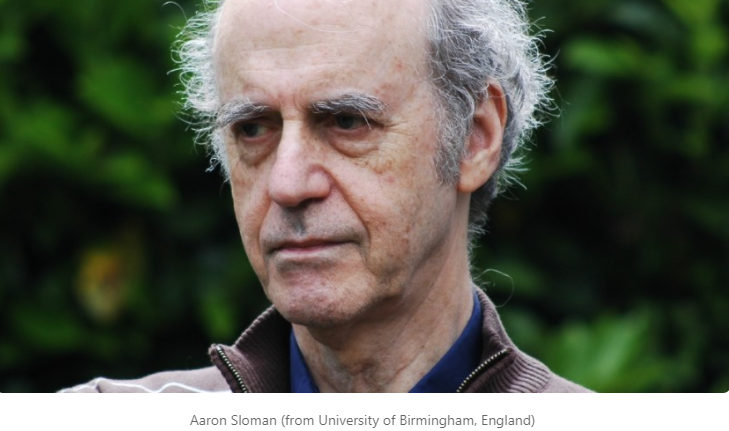
Margaret Boden mentions Aaron Sloman again. This time in reference to consciousness and qualia.
Aaron Sloman’s position (at least as presented by Boden) may be appealing to some anti-physicalists and anti-reductionists in that he argues that you can’t “identif[y] qualia with brain processes”. What’s more, consciousness and qualia “can’t be defined in the language of physical descriptions”. Yet, despite all that, qualia still “have causal effects”.
This position is still a kind of reductionism in that qualia are reduced to “computational states”. It just so happens that these computational states must also be “implemented in some underlying physical mechanism”.
A hint of this necessary requirement for physical implementation (to be discussed later) can be seen in the following passage from Boden:
“For computational states are aspects of virtual machines: they can’t be defined in the language of physical descriptions. But they can exist, and have causal effects, only when implemented in some underlying physical mechanism.”
Admittedly, to some readers it may seem obvious that physical implementation is required. However, to those AI theorists with a more Pythagorean or even dualist disposition (see later section), it may not be obvious. Alternatively, it may simply need stating to them.
So is this token physicalism (or even token reductionism) in that a virtual “computational state” always requires implementation in a physical mechanism? Again, it just so happens that there’s no single physical medium (so such AI theorists believe) that’s required to bring about consciousness.
Yet consciousness is still brought about via physical implementation.
So it doesn’t really seem to matter that virtual machines have a physically neutral and abstract “computational description” which (as it were) allows them to also be implemented in, say, a set of coke cans or in silicon.
Now this is a good place to introduce Patricia Churchland and John Searle into this philosophical fray.
Part Two
Patricia Churchland on Why Brains Matter

The Canadian-American philosopher Patricia Churchland believes that biology (or physical implementation) matters when it comes to consciousness.
Churchland's position is similar to Gerald Edelman’s, who also said that the mind (if not consciousness)
“can only be understood from a biological standpoint, not through physics or computer science or other approaches that ignore the structure of the brain”.
[Gerald Edelman was a biologist and Nobel laureate.]
Churchland herself takes Edelman's position to its logical conclusion when she (more or less) argues that in order to build an artificial brain, one would not only need to replicate the biological brain’s functions: one would also need to replicate everything physical about it.
Indeed, Boden herself mentions the complete replication of the human brain a couple of times in her book.
For example, she writes:
“If so, then no computer (possibly excepting a whole-brain emulation) could have phenomenal consciousness.”
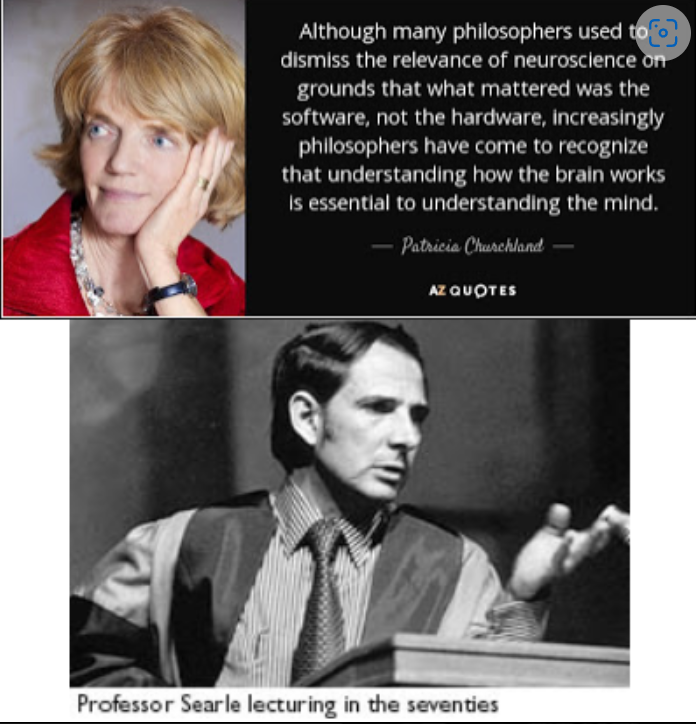
Churchland has the backup of the American philosopher John Searle here. Searle writes:
“Perhaps when we understand how brains do that, we can build conscious artifacts using some non-biological materials that duplicate, and not merely simulate, the causal powers that brains have. But first we need to understand how brains do it.”
Of course, it can now be said that we may be able to have an example of artificial consciousness without also having an artificial brain. Nonetheless, isn’t it precisely this position which many dispute?
In any case, Churchland says that
“it may be that if we had a complete cognitive neurobiology we would find that to build a computer with the same capacities as the human brain, we had to use as structural elements things that behaved very like neurons”.
She continues:
“[T]he artificial units would have to have both action potentials and graded potentials, and a full repertoire of synaptic modifiability, dendritic growth, and so forth.”
It gets even less promising when Churchland says that
“for all we know now, to mimic nervous plasticity efficiently, we might have to mimic very closely even certain subcellular structures”.
Put that way, Churchland makes it seem as if artificial consciousness (if not artificial intelligence) is still a pipe dream.
Churchland then sums up this big problem by saying that
“we simply do not know at what level of organisation one can assume that the physical implementation can vary but the capacities will remain the same”.
That’s an argument which says that it’s wrong to accept the implementation-function (to use a phrase from Jacques Derrida) “binary opposition” in the first place. However, that’s not to say — and Churchland doesn’t say — that it’s wrong to concentrate on virtual machines, functions or cognition generally. It’s just wrong to completely ignore the “physical implementation” in brains. Or, as Churchland herself puts it at the beginning of another paper, it’s wrong to “ignore neuroscience” and focus entirely on function.
It’s worth bringing in John Searle again here.
John Searle on Why Brains Matter

John Searle once wrote the following words:
“For decades, research has been impeded by two mistaken views: first, that consciousness is just a special sort of computer program, a special software in the hardware of the brain; and second that consciousness was just a matter of information processing. The right sort of information processing — or on some views any sort of information processing — would be sufficient to guarantee consciousness.”
Searle continued:
“[I]t is important to remind ourselves how profoundly anti-biological these views are. On these views brains do not really matter. We just happen to be implemented in brains, but any hardware that could carry the program or process the information would do just as well.”
He then concluded with these words:
“I believe, on the contrary, that understanding the nature of consciousness crucially requires understanding how brain processes cause and realize consciousness.”
Oddly, Searle accuses many of those who accuse him of being a “dualist” of being…well, dualists.
Searle’s basic position on this is the following:
i) If AI theorists ignore (or simply play down) the physical biology of brains (or, in this essay’s case, the precise types of implementation of virtual machines),
ii) then that will surely lead to some kind of dualism in which non-physical abstractions (or virtual machines and “their” computations) basically play the role of Descartes’ non-physical and “non-extended” mind.
The position Searle is arguing against is expressed by Margaret Boden herself in the following way:
“As an analogy, think of an orchestra. The instruments have to work. Wood, metal, leather, and cat-gut all have to follow the laws of physics if the music is to happen as it should. But the concert-goers aren’t focussed on that. Rather, they’re interested in the music.”
In this passage from Boden, it can be seen that concert-goers (at the least) aren’t denying that “instruments have to work”, or that they’re made out of “metal, leather, and “cat-gut”. It’s just that they only care about “the music”.
Is this the same kind of thing with Aaron Sloman and other AI theorists who only care about virtual machines and their computational states?
So can there be music and consciousness without physical instruments and physical machines?
On a different tact.
Searle himself is simply noting the radical disjunction created between the actual physical reality of biological brains (or hardware implementations in Boden’s case), and how many AI theorists explain and account for mind and consciousness.
However, it must be stressed here that Searle doesn’t believe that only biological brains can give rise to minds, consciousness and understanding. Searle’s position is that, at present, only biological brains do give rise to minds, consciousness and understanding.
Searle is therefore simply emphasising an empirical fact. In other words, he’s not denying the logical and metaphysical possibility that other things could bring forth mind, consciousness and understanding.
Of course, the people just referred to (who’re involved in artificial intelligence, cognitive science generally and the philosophy of mind) aren’t committed to what used to be called the “Cartesian ego”. (They don’t even mention it.) This means that the charge of “dualism” seems to be a little unwarranted. However, someone can be a dualist without being a Cartesian dualist. Or, more accurately, someone can be a dualist without that person positing some kind of non-material substance (formerly known as the Cartesian ego).
That said, just as the Cartesian ego is non-material and non-extended (or non-spatial), so too are the (as Searle puts it) “computational operations on formal symbols” which are much loved by those involved in AI, cognitive science and whatnot.
Now let’s return to Aaron Sloman.
Roger Penrose on Why Brains Matter
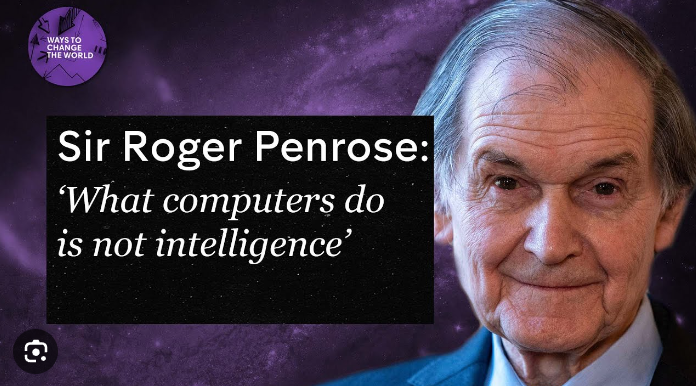
The least that can be said about Aaron Sloman’s position (as discussed earlier) is that it isn’t dualist… in the traditional sense of that word. That said, Sloman’s stress on computational (therefore mathematical) states may, instead, come across as Pythagorean in nature.
Yet again, these (as it were) Pythagorean states still need to be physically implemented. That is, they may well exist in a pure abstract (platonic?) space. However, when they (as it were) come along with consciousness, then they must be physically implemented.
So the English mathematician and mathematical physicist Roger Penrose may seem like an odd person to bring in here. However, he particularly picked up on (what he deemed to be) some of the (hidden) Platonist assumptions of most AI theorists and some philosophers.
Roger Penrose, specifically, raises the issue of the physical (what he calls) “enaction” of a (in his case) algorithm. He wrote:
“The issue of what physical actions should count as actually enacting an algorithm is profoundly unclear.”
Then this problem is seen to lead — logically — to a kind of Platonism.
Penrose continues:
“Perhaps such actions are not necessary at all, and [] the mere Platonic mathematical existence of the algorithm would be sufficient for its ‘awareness’ to be present.”
Of course, no AI theorist would ever claim that even his Marvellous Algorithm doesn’t need to be enacted at the end of the day. In addition, he’d probably scoff at Penrose’s idea that
“the mere Platonic mathematical existence of the algorithm would be sufficient for its ‘awareness’ to be present”.
Yet surely Penrose does have a point.
If it’s literally all about algorithms or (in this essay’s case) virtual machines (which can be “multiply realised”), then why can’t the relevant algorithms or virtual machines do the required job entirely on their own? That is, why don’t these abstract algorithms or virtual machines automatically instantiate consciousness (to be metaphorical for a moment) while floating around in their own abstract spaces?
To repeat. Penrose’s position can be expressed in simple terms.
If the strong AI position is all about algorithms or virtual machines, then literally any implementation of a Marvellous Algorithm or Marvellous Virtual Machine would bring about consciousness and (in Penrose’s own case) understanding.
More specifically, Penrose focuses on a single qualium (i.e., the singular of ‘qualia’). He writes:
“Such an implementation would, according to the proponents of such a suggestion, have to evoke the actual experience of the intended qualium.”
If the precise hardware doesn’t matter at all, then only the Marvellous Algorithm (or Marvellous Virtual Machine) matters. Of course, the Marvellous Algorithm (or Marvellous Virtual Machine) would need to be implemented… in something. Yet this may not be the case if we follow the strong AI position to its logical conclusion…
Or at least this conclusion can be drawn out of Roger Penrose’s own words.
Notes:
(1) What should we make of the logical-positive-type phrase “the concept zombie is incoherent”? (That’s if Margaret Boden is correctly expressing the positions of Daniel Dennett and Aaron Sloman.)
Well, there may well be very-strong arguments against the concept zombie. (Actually, arguments against what is said about philosophical zombies.) However, that concept doesn’t thereby become “incoherent”. (Or, as the logical positivists once put it about statements, it doesn’t thereby become “meaningless”.)
(2) It can’t be a solely functionalist or even verificationist position either, even if these two isms can easily run alongside behaviourism.
(*) The subject of qualia was mentioned a couple of times in the essay above. See my essay ‘Margaret Boden on Qualia and Artificial Intelligence (AI)’.
Saturday 23 March 2024
Does ‘Wigner’s Friend’ Support Consciousness-First Physics?
Schrödinger’s cat is a reductio ad absurdum. So too is Wigner’s friend. Both are related examples of thought experiments which were (as it were) designed to show how and why a particular position (or theory) is absurd.
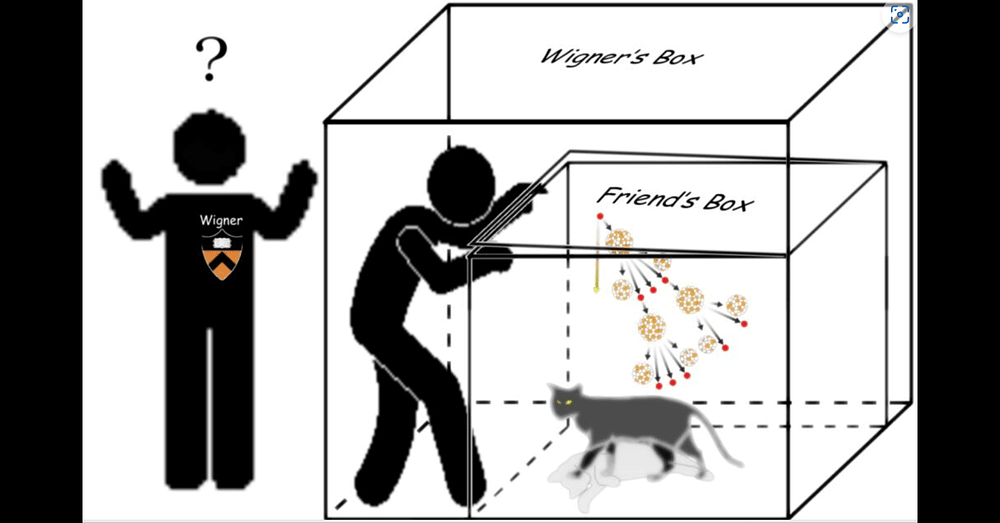

Schrödinger on the Collapse of the Wavefunction
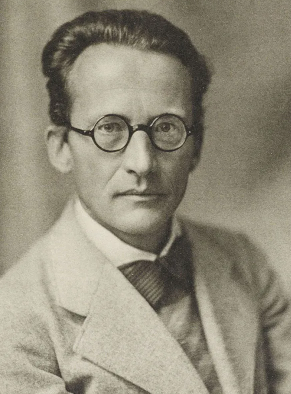
The Austrian physicist Erwin Schrödinger (1887–1961) pointed out something which has now become commonplace: that there’s nothing in the (or a) wavefunction itself about (its own) collapse.
Way back in 1927, it was Werner Heisenberg who first used this idea to explain why physicists only find a single (to use Schrödinger’s own word) “alternative” at the end of an experiment. In other words, experimenters never observe a quantum superposition of alternatives states.
Yet Schrödinger himself reacted against Heisenberg’s notion of the collapse of the wave function by what the former called “the observer”.
In a paper published in 1952 (‘Are There Quantum Jumps?’), Schrödinger went further when he stated that it’s “patently absurd” that the wave function should
“be controlled in two entirely different ways, at times by the wave equation, but occasionally by direct interference of the observer, not controlled by the wave equation”.
From this passage alone, it can be seen that there’s a strong hint at the issue which the Wigner’s Friend thought experiment itself tackles. (This is particularly true of the clause, “the observer [is] not controlled by the wave equation”.)
To explain.
The physicist has the option of collapsing the wave function. And only then is the possibility (or reality) of so many mutually-contradictory alternatives existing together no longer a problem. In other words, the collapse (as it were) brings to an end all those alternatives existing together…
Except that this issue isn’t really solved at all — at least not philosophically.
That’s simply because we’ve moved away from one problematic situation (i.e., the wavefunction’s many alternatives existing together before its collapse), to another problematic situation (i.e., the actual collapse of the wavefunction into a single state).
To state the obvious: there wouldn’t even be any “collapse of the wavefunction” if there wasn’t a previous wave function which (as it were) needed to be collapsed.
Yet on Schrödinger’s (possibly?) “lunatic” multiple-alternatives version, the wavefunction isn’t collapsed at all. Instead, one single (in this case at least) cat must be both dead and alive.
Schrödinger’s Many Worlds?
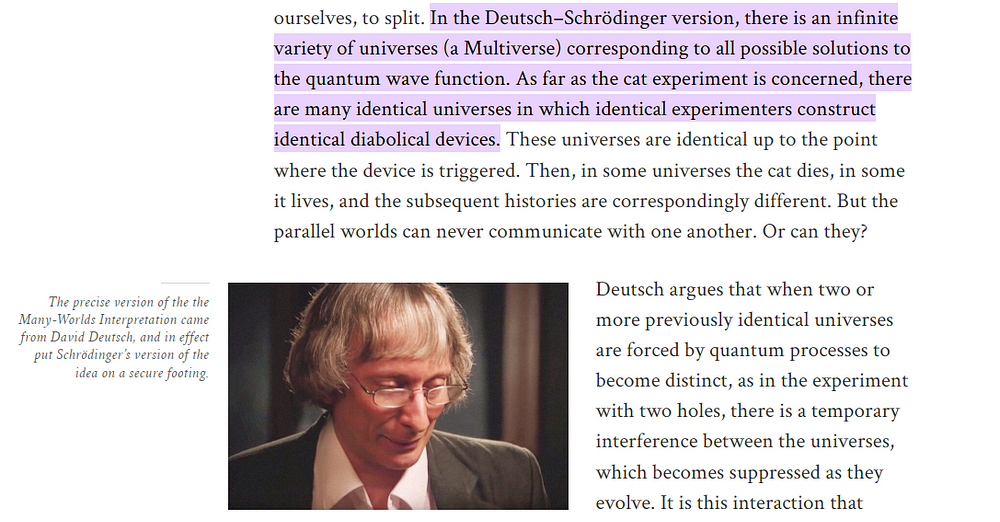
It must be stressed here that Schrödinger certainly didn’t put any of the above in the way I’ve just done. Instead, he simply raised the possibility that all the wavefunction’s alternatives happen simultaneously (i.e., if seen only in accordance with the mathematics of the wavefunction itself). And this, then, must also be true of all the quantum objects which are part of (or described by) each wavefunction. [See my ‘Erwin Schrödinger on the Many Worlds of the Wave Function’.]
Schrödinger gets (to use the cliche) weirder.
He actually said that all the probabilities in the wavefunction
“may not be alternatives [ ] but all really happen simultaneously”.
Well, according to the wavefunction, they actually do all happen simultaneously…
Or do they?
It depends.
In any case, the issue here can be summed up technically and philosophically by saying that the mathematical probabilities (or ‘probability amplitudes’) of the wavefunction are effectively concretised (or reified) by quantum interpreters when they assign physical phenomena to “what the maths says”.
Alternatively, perhaps it can be said that the wavefunction itself concretises all (as it were) its probabilities (or Schrödinger’s “alternatives”).
To repeat.
It can basically — as well as accurately — be said that with the wavefunction, there are actually many alternatives happening simultaneously. Thus, such (supposed) “weirdness” is entirely a product of the wavefunction itself.
In broader terms, then, the quantum theorist (or interpreter) has no right to say that these many alternatives do not all occur together. In other words, if a theorist shouldn't really say anything about an unobserved realm (or a realm beyond the wavefunction), then what right has he to say that such alternatives don’t all occur together? After all, the wave function is (as it’s put) telling him that they do all occur together.
Thus, in order to demonstrate that these alternatives aren’t really happening simultaneously, a quantum theorist would need to move beyond the maths, and enter the weird and mysterious world of… interpretation.
In other words, the quantum theorist would need to offer an interpretation of all the mathematics.
To change tack a little.
The title of this essay is ‘Does ‘Wigner’s Friend’ Support Consciousness-First Physics?’. So there’s a reference to consciousness in that title.
Schrödinger’s Scientific Realism
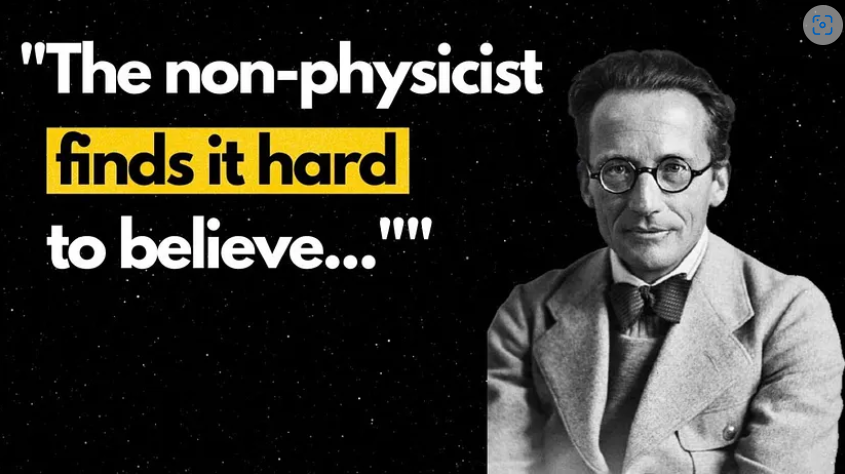
Despite the fact that many idealists, New Agers and spiritual commentators recruit Schrödinger into their various causes (see here, and their stress on Schrödinger’s “anti-materialism”), it’s clear that, as far as quantum mechanics itself is concerned, he wasn’t an idealist. Indeed, it’s also tempting to say that Schrödinger was the exact opposite of an idealist. (If that way of putting things even makes sense.)…
But, sure, in Schrödinger’s private and non-scientific life, perhaps he was an idealist, as well as a “spiritual person”.
In any case, let’s go into more detail on this.
In basic terms, Schrödinger had a problem with the stress on consciousness (or simply on observation) in the Copenhagen interpretation of quantum mechanics. That was because he argued that the collapse of the wave function (as already stated) is as weird (or even weirder) than the content of the wavefunction itself…
Was Schrödinger right?
Think about this story.
The wavefunction — as well as what it “describes”?- is a certain way, and then a (mere) observation stops it from being that certain way.
So can we now conclude that if this is truly the case, then such an observation literally changes reality. (This is the case without the observation or experimenter having any physical impact on the experimental setup.)
All this means that Schrödinger certainly played down the role of consciousness in quantum mechanics. (That’s despite what Schrödinger’s idealist and spiritual quoters and fans claim or merely hint at. See note 1.)
So it can — easily? — be argued that Schrödinger was a realist. [See ‘Scientific realism’.]
Alternatively, and in purely philosophical terms, Schrödinger appears to have been a metaphysical realist — at least on this precise subject. [See ‘Metaphysical realism’ and ‘Philosophical realism’.]
To explain Schrödinger’s scientific realism some more.
Schrödinger claimed that nature (or the world) was a certain determinate way before any act of observation.
Granted that in this account it’s essentially the wavefunction (or, to use Schrödinger’s own words, “what [the wave function] says”) which is real. Yet the wavefunction is, after all, supposedly telling is something about the world. Thus, in this instance at least, there are (or were) multiple (mutually contradictory) alternatives happening simultaneously!
So can all this be solved by arguing that there’s a dead cat in our universe, and an alive cat (its counterpart) in another universe?
Let’s now move on from Erwin Schrödinger to Hugh Everett and his “many worlds theory”.
Hugh Everett’s Many Worlds, and Wigner’s Friend
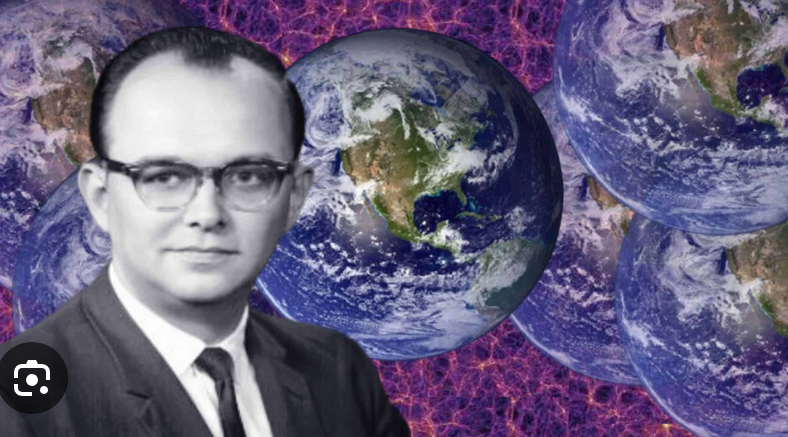
In the foundational many-worlds text ‘“Relative state” formulation of quantum mechanics’ (1957), Hugh Everett III actually mentioned what he called the “amusing, but extremely hypothetical drama” that is Wigner’s Friend thought experiment.
Oddly enough, researchers later found that in an early draft (i.e., earlier than 1957) of this doctoral thesis, Everett discussed the Wigner’s Friend thought experiment — without mentioning either Wigner or the words “Wigner’s friend”! In other words, this idea was in Everett’s mind years before Wigner’s 1961/67 paper, ‘Remarks on the mind-body question’.
In any case, Everett was a student of Wigner. So this means that they must have discussed the Wigner’s Friend scenario together at some point.
Anyway, that’s the history, what about the many-worlds theory itself?
In the many-worlds theory (as hinted at earlier), we can make sense of everything Schrödinger said earlier by bringing in other “worlds”. That is, if we bring in another world, then one cat is alive in that world, and another cat (its counterpart) is dead in our own world (or vice versa).
In other words, when the box is opened, we find only a dead cat. And that box-opening is equivalent to an observation (or the collapse) of the wavefunction.
So did Hugh Everett and Eugene Wigner actually differ on this issue?
Wigner believed that the consciousness of an observer is responsible for the collapse of the wavefunction (i.e., regardless of any refences to anyone’s “friend”, etc.). Everett, on the other hand, stressed the objectivity and non-perspectival aspects of his many-worlds theory.
What’s more, Everett claimed to have solved the Wigner’s friend “paradox” by bringing in different worlds.
It must now be said that Wigner himself didn’t believe that a conscious observer can also be in a state of superposition. However, he did acknowledge that this is the end result (i.e., a reductio ad absurdum) of his own thought experiment. Indeed, that was his thought experiment’s central point.
Wigner’s actual position, however, was that the wavefunction had already been collapsed when his “friend” observed the cat (or when he observed any given quantum system).
Now if we relate all this specifically to the Wigner’s Friend scenario.
Some Technical Details
Wigner’s friend measures, say, the spin of an electron (or the life-status of a cat). This results in a branching of the (or our) world into two parallel worlds. In one world, Wigner’s friend has measured the spin to be 1 (or the cat to be alive). At another world, the very same friend (i.e., Wigner’s friend) obtains the measurement outcome 0 (or the cat being dead).
So what about Wigner and his friend when taken together as a joint (quantum) system?
When Wigner himself measures the combined system of his friend (qua system) and the electron-spin-system (or cat-system), then that system splits again into two parallel worlds.
Now let’s sum up Wigner’s Friend again.
If I collapse the wave function of, say, an electron (or a cat), then my friend has to observe me collapsing (or offering him information about) the electron’s (or cat’s) wave function. More relevantly, my friend needs to collapse the wavefunction that is myself collapsing the electron’s (or cat’s) wavefunction…
This is where it gets bizarre.
If this is the case, then, a friend of my friend will need to observe my own friend in order to collapse his wavefunction, which is actually now my friend+myself+an electron (or a cat). In other words, my friend’s friend is collapsing the wavefunction which is my friend collapsing the electron’s (or cat’s) wavefunction, and that wavefunction includes myself collapsing the electron’s (or cat’s) wavefunction. And so on…
The theoretical physicist Carlo Rovelli puts all the above in both a technical and a philosophical way.
Carlo Rovelli on Wigner’s Friend
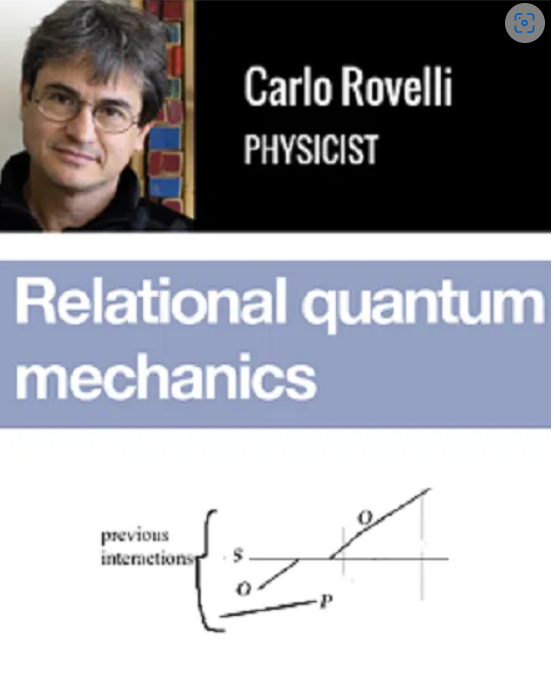
In Carlo Rovelli’s philosophical system, we have what he calls an “observer system” O (which he sees as an epistemic system), which interacts with a quantum system S (which he sees as an ontological system). [See Rovelli’s ‘Relational quantum mechanics’.]
We therefore need to take into account the fact that there are (or at least there can be) different accounts of the very same quantum system. (This is a variation on the notion of the “underdetermination of theory by evidence”.)
In more technical detail on the wavefunction and its alternatives.
System S is in a superposition of two or more states.
A theorist or experimenter can “collapse” this system to achieve an “eigenstate”, which is both determinate and circumscribed.
All this means that if we have two or more interpretations of system S, then what scientists call “observers” must have been brought into the story. And that also means that there must be additional relations (or what Rovelli calls “interactions”) to consider between system S itself, and things outside S.
In terms specifically of Wigner’s Friend.
This also means (or at least it can mean) that we need a second observer (O’) to observe the observer-system (O), who (or which), in turn, has observed (or is observing) quantum system S.
All this multiplies relations (or interactions) indefinitely.
Indeed, perhaps we even have some kind of infinite regress on our hands here.
Now another important part of this story needs to be told.
In simple terms, consciousness-first theorists dispute the idea that an instrument can, on its own, collapse the wavefunction.
Michio Kaku picks up on this debate.
Michio Kaku on Observers vs Cameras

The physicist Michio Kaku tackles this issue in terms of the specific case of human observers vs cameras.
“Some people, who dislike introducing consciousness into physics, claim that a camera can make an observation of an electron, hence wave functions can collapse without resorting to conscious beings.”
Prima facie, even the phrase “a camera can make an observation of an electron” seems odd. Indeed, it seems anthropomorphic to claim that a camera— alone! — can observe anything.
Isn’t it the case that human beings use cameras in order to observe things?
However, perhaps this is just a semantic issue. [See note 2.]
In any case, Kaku then raises the following problem:
“But then who is to say if the camera exists? Another camera is necessary to ‘observe’ the first camera and collapse its wave function. Then a second camera is necessary to observe the first camera, and a third camera to observe the second camera, ad infinitum.”
This is a (as it were) concrete example of the problem of Wigner’s Friend.
Firstly, Kaku’s words are about a camera which is supposed to observe a cat (or a quantum system) all on its own. Kaku also seems to be bringing up the issue of this camera’s very existence as it was before it too was observed. Or, at the very least, Kaku brings up the issue of the camera’s wavefunction itself being required in order for the cameras to (as it were) exist!
Is this an anti-realist (if not idealist) point about the very nature and role of so-far unobserved (as it were) noumena?
All that said, isn’t it the case that Kaku’s camera still registered something regardless of any minds that later made sense of (or interpreted) that registration? (Schrödinger, again, talked in terms of minds “giv[ing] it meaning”.)
Some readers may question about the word “registered”. (I quibbled earlier about the word “observed” when it came to Kaku’s camera observing all on its own.)
In this case at least, all “registered” means is the following:
Prior to observation, something left some kind of physical imprint on the camera.
Yet it’s still the case that what the camera supposedly registered (or “observed”) may not have any role to play until what it registered (or observed) is also registered (or observed) by another camera. More relevantly, what the camera registered (or observed) may not have any role to play until it too is interpreted by an actual human mind.
Notes:
(1) Idealists, New Agers, and spiritual commentators conflate Schrödinger’s (mitigated) anti-materialism with an equal stress on the prime importance of consciousness. Schrödinger may well have been an anti-materialist in some ways. However, he certainly didn’t place consciousness at the forefront of his physics.
(2) Scientists can use old terms in completely new ways. True. Yet it also depends on others knowing that, as well as on whether or not scientists actually are using old terms in new ways.






